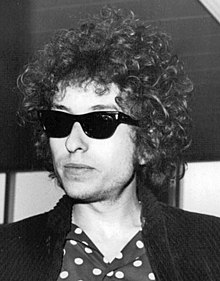On July 29, four days after Newport, Dylan was back in the studio in New York, recording "Positively 4th Street". The lyrics contained images of vengeance and paranoia, and have been interpreted as Dylan's put-down of former friends from the folk community he had known in clubs along West 4th Street.
Highway 61 Revisited and Blonde on Blonde
In July 1965, Dylan's six-minute single "Like a Rolling Stone" peaked at number two in the U.S. chart. In 2004 and in 2011, Rolling Stone listed it as number one of "The 500 Greatest Songs of All Time". Bruce Springsteen, in his speech for Dylan's inauguration into the Rock and Roll Hall of Fame, said that on first hearing the single, "that snare shot sounded like somebody'd kicked open the door to your mind." The song opened Dylan's next album, Highway 61 Revisited, named after the road that led from Dylan's Minnesota to the musical hotbed of New Orleans. The songs were in the same vein as the hit single, flavored by Mike Bloomfield's blues guitar and Al Kooper's organ riffs. "Desolation Row", backed by acoustic guitar and understated bass, offers the sole exception, with Dylan alluding to figures in Western culture in a song described by Andy Gill as "an 11-minute epic of entropy, which takes the form of a Fellini-esque parade of grotesques and oddities featuring a huge cast of celebrated characters, some historical (Einstein, Nero), some biblical (Noah, Cain and Abel), some fictional (Ophelia, Romeo, Cinderella), some literary (T. S. Eliot and Ezra Pound), and some who fit into none of the above categories, notably Dr. Filth and his dubious nurse".
In support of the album, Dylan was booked for two U.S. concerts with Al Kooper and Harvey Brooks from his studio crew and Robbie Robertson and Levon Helm, former members of Ronnie Hawkins's backing band the Hawks.


Niciun comentariu:
Trimiteți un comentariu